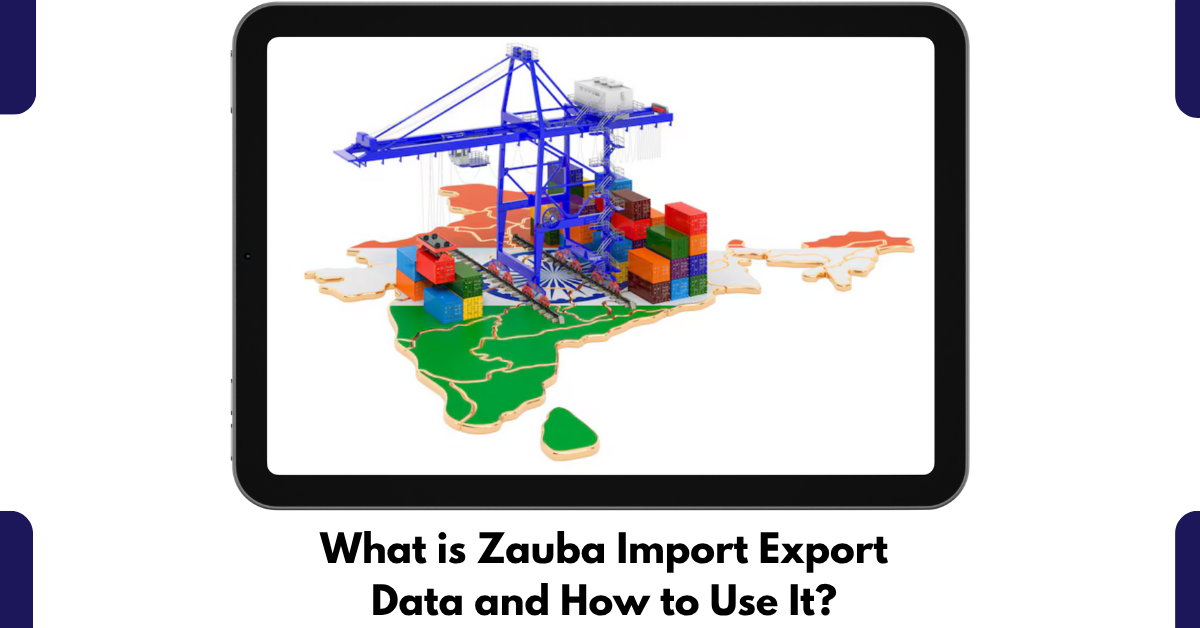Unlocking the World of Trade Intelligence
With the world’s economies increasingly interconnected, the flow of goods across borders characterizes the lifeblood of business. Every product exported, every commodity that enters, and every material that goes out leaves behind some information trail that is of immense utility to businesses, policymakers, and entrepreneurs alike. However, most of this data lies dormant, buried deep in intricate trade records. That’s where Zauba import export data comes in – a revolutionary instrument that equips companies with the ability to decipher global trade patterns, predict market trends, and develop fact-based strategies for expansion.
Trade is not so much about the movement of goods anymore. It’s about making use of information. Knowing how imports and exports influence markets gives a tremendous competitive advantage. Companies utilizing trade intelligence tools like Zauba import data and Zauba import data India are able to better spot opportunities, mitigate risks, and leave competitors behind.
Understanding the Value of Zauba Import Export Data
The Rise of Trade Data Platforms
International trade produces billions of records every year. It is almost impossible to manually scrutinize these records. Zauba Corp and other platforms have filled this void by compiling, categorizing, and showing trade data in an organized manner. With precise details like shipment details, port transactions, and country patterns, Zauba import export data India makes decision-making easier for businesses dealing with domestic and global markets.
Why Businesses Turn to Zauba Import Data
Zauba import export data 2025 strength comes from its capacity to reveal latent trends. A drug manufacturer, for instance, can monitor raw material imports, whereas a maker of electronics can analyze semiconductor chip imports by volume. These level-of-detail insights assist companies in predicting demand, synchronizing supply chains, and even anticipating competitor actions.
In addition, policymakers and experts can utilize free import export data to determine trade imbalances, identify inconsistencies, or verify observance of global trade rules. The data, thus, benefits not only businesses but also institutions making economic policy.
How Zauba Import Export Data Works
The Role of HS Codes in Trade
Underlying trade documentation is the Zauba HS Code system, which classifies products for uniformity in international trade. Each product has a specific HS (Harmonized System) code assigned to ensure precise identification across nations. Together with Zauba import export data India, such codes enable companies to conduct in-depth product-specific research.
For example, an organization that wants to import renewable energy machinery can browse through the relevant Zauba HS Code to find suppliers, quantities, and trends. This eliminates uncertainty and simplifies market analysis and allows firms to make strategic sourcing decisions.
Data Collection and Structure
Zauba Corp gathers data from government trade reports, customs reports, and port data. This data is then organized into actionable datasets containing:
– Importer and exporter information
– Commodity names
– HS codes
– Shipment weight and volume
– Port of origin and destination
– Declared values
Through the processing of raw customs data into usable intelligence, sites such as Zauba provide order from chaos.
Applications of Zauba Import Export Data
Market Research and Competitive Analysis
One of the strongest applications of Zauba import export data India is competitive benchmarking. A company can monitor competitors’ procurement behavior, price trends, and buyer networks. This information assists firms in optimizing their own procurement and marketing strategies.
For instance, a textile garment maker can analyze the import statistics of textile raw materials to know where the countries are selling fabrics at the lowest prices. By comparing shipment quantities with the declared values, they can detect latent efficiency in their competitors’ supply chains.
Supply Chain Optimization
Supply chains live on predictability. Zauba import data India aids in anticipating interruptions by tracking trade. When imports of essential raw materials reduce because of geopolitical tensions or port bottlenecks, companies can make anticipatory adjustments to sourcing strategies.
Risk Management and Compliance
Global trade norms change every day. Businesses require accurate information to stay compliant. Zauba import export data 2025 can be used by firms to make shipments compliant with trade laws, tariff regimes, and environmental rules. Quickly checking the source of goods also reduces risks associated with counterfeit or non-compliant products.
Policy Making and Economic Planning
Governments and trade organizations both gain equally. Transparent free import export data gives insight into trade flows so that policymakers can assess trade agreements, track economic well-being, and implement strategic policies that stimulate domestic manufacturing.
The Future of Zauba Import Export Data 2025
Technological Enhancements
The ecosystem of trade data is changing at a fast pace. With AI and machine learning-powered analytics, analysis of Zauba import export data 2025 will be predictive in nature rather than descriptive. Rather than monitoring mere historical shipments, companies can predict upcoming trends and model scenarios with greater precision.
Democratization of Data
Earlier, trade intelligence was available only to big companies with fat wallets. Now, resources such as free import export data are bringing things on a level footing, and small and medium enterprises are able to take informed business decisions. This democratization should lead to fairer competition in the international market.
Integration with Global Platforms
As trade becomes more integrated, Zauba Corp and other such platforms will increasingly get connected with international data networks, and a more interconnected picture of global supply chains will emerge. Zauba Corp will provide businesses in India with an unprecedented level of international trade intelligence, thanks to this integration.
Taking Action with Zauba Import Export Data
Practical Steps for Businesses
Map Products to Correct Zauba HS Code: Begin by mapping your goods to the appropriate Zauba HS Code.
Analyze Competitor Activity: Utilize Zauba import data to analyze competitors’ shipping and sourcing habits.
Optimize Sourcing Strategies: Utilize knowledge gained from Zauba import data India to diversify suppliers and achieve better prices.
Monitor Policy Changes: Remain ahead of policy changes using revised Zauba import export data India.
Leverage Predictive Analytics: Utilize insights from Zauba import export data 2025 for planning in the long term.
Why It Matters
In the high-stakes game of global trade, information is as indispensable as funds. Zauba import export data India empowers companies with the foresight required to evolve, innovate, and succeed. Whether it is venturing into emerging markets, fortifying supply lines, or reducing threats, actionable insights are the building blocks of robust decision-making.
Conclusion: Transforming Trade Intelligence into Growth
Each shipment has a tale to tell. Each dataset holds a promise. Leveraging the power of Zauba import export data, Indian businesses, as well as those worldwide, can take their trade approach from speculation to accuracy. The union of organized data, predictive analysis, and world integration makes Zauba Corp an essential tool for the age of commerce.
From compliance management to competitive benchmarking, the uses are limitless. As the future takes shape, those who accept Zauba import export data 2025 will innovate with clarity, agility, and confidence. True strength isn’t merely in gaining access to data but making effective use of it.
FAQs on Zauba Import Export Data
Q1. What is Zauba import export data?
It is a trade database that provides shipment-level details of India’s imports and exports.
Q2. How does Zauba collect data?
Zauba sources trade records from Indian customs, shipping bills, and logistics partners.
Q3. What information is included in Zauba data?
It includes HS codes, product descriptions, importer/exporter names, origin country, destination country, quantity, and port details.
Q4. Who uses Zauba import export data?
Exporters, importers, manufacturers, logistics providers, and market researchers rely on it for business insights.
Q5. Is Zauba data free to access?
Some basic information is accessible, but detailed trade data often requires a paid subscription.



